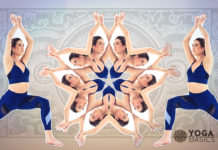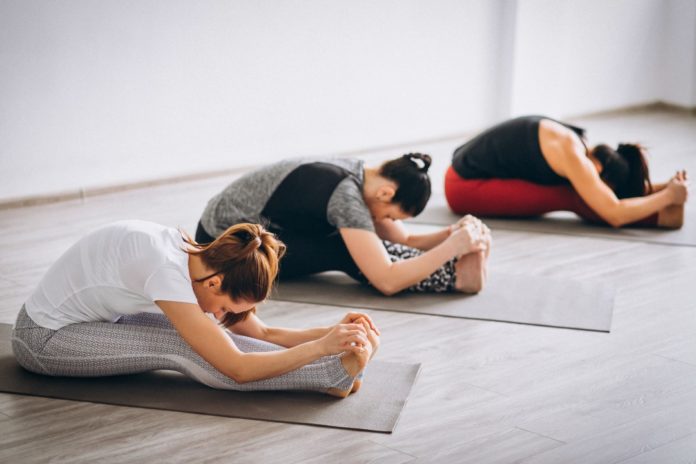It may sound odd, but for me, that radiant and relaxed feeling we often associate with yoga didn’t come from a slow-paced yoga practice. It came after getting my butt kicked in a sweaty, strength-focused asana class. Not only did my vigorous fast-paced yoga practice offer me a physical and mental release, but I assumed that the residual soreness in my hips and hamstrings the following day meant I was doing everything right. Fortunately, I soon discovered that gentle yoga offers the same great feelings without all the sweat, soreness and pain.
What is gentle yoga?
Gentle yoga is essentially what it sounds like—a gentler style of hatha yoga practice. It is performed at a slower pace, with less intense positions, and usually includes extended time for meditation, yogic breath work, and relaxation. A gentle class usually includes more warm up movements and the yoga postures are often held for longer times. Modifications are done to help people of all fitness levels enjoy the benefits of yoga without putting themselves at risk for injuries. There is a stronger emphasis on stretching, seated poses and low-impact movements in these classes.
A slower and gentler practice of yoga allows a person to move at a comfortable pace, does not push them to do anything that may make them uncomfortable, and creates less strain on their muscles and joints.
Gentle yoga can be practiced by just about anyone, regardless of age or physical condition. It is especially great for people with injuries, pain, mobility or health issues. A gentle yoga practice is a great choice for anyone who is afraid they are not flexible or fit enough to do the yoga poses.
Benefits of gentle yoga
Gentle yoga, with its emphasis on breathing and quiet reflection, allows us to come away feeling flexible in our bodies, relaxed in our minds, and calmed in our nervous systems. Gentler practices often provide rewards: mental, physiological and spiritual rejuvenation, without having to endure the sweat and tears first.
For some people, the thought of a gentle yoga class seems boring or not physically or mentally advantageous. But I assure you, whether you choose a restorative, yin or a slow-moving hatha yoga class, your body will benefit in a myriad of ways. A gentler style of yoga calms the nervous system so that the parasympathetic nervous system can be engaged. This encourages better digestion, a decrease in stress levels, and an enhanced ability to relax and heal. These classes are perfect fits for people who have trouble falling asleep at night, are constantly running through their to-do lists on their lunch breaks, or whose bodies feel tight and restless.
If you are a power or hot yoga junky who is doubtful about trying a gentler practice, know that you don’t have to throw away your sweat sessions altogether. Incorporating a gentle, restorative or yin practice just once a week will help you maintain balance in your body, avoid yoga burnout and get to know your body and mind in different ways. And think of it this way: if you’re really resistant to practicing gentle yoga, there may be some valuable lessons to be learned there. If you’ve limited yourself to one type of yoga, considering going beyond that limitation and opening up to a new, slower form of practice.
Who is gentle yoga for?
- Beginners who want an easy and slow class to start
- People with reduced levels of fitness, strength, mobility or flexibility
- Seniors
- Students with chronic health issues or injuries
- Pregnant women
- Overweight students
- Patients recovering from surgery or chemotherapy
- Anyone who wants to experience a slow, mindful and meditative practice
Gentle Yoga Styles
There are many different types of gentle classes you can explore. Each one will have a unique pace and style of movement. Explore them all to find the class that works best with your personality, personal needs and goals.
- Yin
Contrary to how it sounds, yin yoga isn’t exactly “easy.” In this class, students hold poses (mostly on the floor) for 3-5 minutes at a time to access deep layers of muscle and achieve deep physical release. For some, the length of time spent in a posture can be mentally challenging, contributing to improved focus and concentration. Yin yoga is especially good for yogis who frequently practice more athletic styles of yoga. Incorporate one yin yoga class or a few yin yoga poses throughout the week, and you’ll likely feel more balanced in your body. - Restorative Yoga
These classes might feel more like nap time than yoga for the uninitiated, but my advice? Just go with it. In restorative classes, students hold poses for up to 10 minutes (or more), supported by props so that your body can fully relax. The goal of restorative yoga is not necessarily to stretch, but to give in to opening through support so that your muscles, nervous system and mind can truly let go and release into relaxation. - Kripalu
This school of yoga teaches classes that are generally mindful and gentle. Kripalu classes are often coined “meditation in motion” as they emphasize meditation, mindfulness, and breath work. Students are encouraged to explore and observe the energetic aspects of the practice. - Chair Yoga
This class uses a chair for most or all of the yoga postures. A folding chair is used as a support, making this a very easy class for seniors and those with medical conditions. - Gentle
Gentle yoga classes can take many forms, but typically, gentle classes use basic yoga poses in a slow, low-impact way. You might find yourself flowing from pose to pose. Or you might find yourself staying with one pose for a longer amount of time. Without a doubt, you will be stretching, breathing, and feeling rejuvenated when you walk out the door.
Is gentle for you?
Gentle yoga is a style of yoga that best helps students who are injured, older, or just beginning to practice. Gentle yoga is a great choice for people who want to try yoga but is afraid they are not flexible or fit enough to do so. As with any physical activity, it’s important to choose a yoga style that’s appropriate for your current physical and mental condition.
Conclusion
Like most yogis, I fell in love with yoga because of the way it made me feel. I used to think I had to push my body in order to release pent up energy and find relaxation. It took a while, but I eventually realized there is more than one way to feel amazing after a yoga session. While I still practice athletic yoga styles like ashtanga and vinyasa, I’ve created a more balanced yoga practice by taking regular classes of different gentle yoga styles.


























